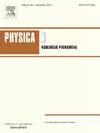Spatiotemporal evolution model for compression of mixing width in reshocked Richtmyer-Meshkov turbulence
IF 2.7
3区 数学
Q1 MATHEMATICS, APPLIED
引用次数: 0
Abstract
Turbulent mixing induced by reshocked Richtmyer-Meshkov (RM) instability is a critical process in both natural phenomena and high-energy-density applications. Among the physical quantities describing RM turbulent mixing, the mixing width is of fundamental importance. Although its temporal evolution has been extensively studied in the past several decades, there is currently no quantitative model for the compression of the mixing width caused by second shock waves. This study presents a model to predict its spatiotemporal evolution in compression process. By combining the Whitham method with Rankine–Hugoniot relations, we quantify the spatiotemporal evolution of the associated physical quantities when shock waves traverse variable-density mixing zones. Furthermore, using these quantities, we derive a model for the spatiotemporal evolution of mixing width, as well as compression rate. Good agreement between the model predictions and numerical simulations across cases with varying density ratios, incident shock waves, and density profiles confirms the model's accuracy. These findings are crucial for developing a unified model for the entire multi-stage evolution of RM turbulent mixing width, with significant implications for high-energy-density physics and engineering applications.
再激波richmyer - meshkov湍流中混合宽度压缩的时空演化模型
再激波richmyer - meshkov (RM)不稳定性引起的湍流混合是自然现象和高能量密度应用中的一个关键过程。在描述RM湍流混合的物理量中,混合宽度是最重要的物理量。虽然在过去的几十年里对其时间演化进行了广泛的研究,但目前还没有一个定量的模型来描述二次激波对混合宽度的压缩。本研究提出了一个预测其压缩过程时空演化的模型。通过将Whitham方法与Rankine-Hugoniot关系相结合,我们量化了激波穿过变密度混合区时相关物理量的时空演变。此外,利用这些量,我们推导了混合宽度和压缩率的时空演化模型。在不同密度比、入射激波和密度分布的情况下,模型预测与数值模拟之间的良好一致性证实了模型的准确性。这些发现对于建立RM湍流混合宽度整个多阶段演化的统一模型至关重要,对高能量密度物理和工程应用具有重要意义。
本文章由计算机程序翻译,如有差异,请以英文原文为准。
求助全文
约1分钟内获得全文
求助全文
来源期刊

Physica D: Nonlinear Phenomena
物理-物理:数学物理
CiteScore
7.30
自引率
7.50%
发文量
213
审稿时长
65 days
期刊介绍:
Physica D (Nonlinear Phenomena) publishes research and review articles reporting on experimental and theoretical works, techniques and ideas that advance the understanding of nonlinear phenomena. Topics encompass wave motion in physical, chemical and biological systems; physical or biological phenomena governed by nonlinear field equations, including hydrodynamics and turbulence; pattern formation and cooperative phenomena; instability, bifurcations, chaos, and space-time disorder; integrable/Hamiltonian systems; asymptotic analysis and, more generally, mathematical methods for nonlinear systems.
 求助内容:
求助内容: 应助结果提醒方式:
应助结果提醒方式:


